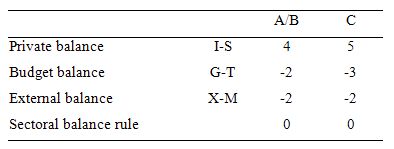
Only one of the following propositions is possible (with all balances expressed as a per cent of GDP).
Answer: A nation can run an external deficit and equal government surplus while the private domestic sector is dis-saving overall.
The best answer is the second option - "A nation can run an external deficit and equal government surplus while the private domestic sector is dis-saving overall".
This is a question about the sectoral balances - the government budget balance, the external balance and the private domestic balance - that have to always add to zero because they are derived as an accounting identity from the national accounts.
See the explanation in Question 1 for background.
The following Table represents the three options in percent of GDP terms. To aid interpretation remember that (I-S) > 0 means that the private domestic sector is spending more than they are earning; that (G-T) < 0 means that the government is running a surplus because T > G; and (X-M) < 0 means the external position is in deficit because imports are greater than exports.
The first two possibilities we might call A and B:
A: A nation can run an external deficit and equal government surplus while the private domestic sector is saving overall.
B: A nation can run an external deficit and equal government surplus while the private domestic sector is dis-saving overall.
So Option A says the private domestic sector is saving overall, whereas Option B say the private domestic sector is dis-saving (and going into increasing indebtedness). These options are captured in the first column of the Table. So the arithmetic example depicts an external sector deficit of 2 per cent of GDP and an offsetting budget surplus of 2 per cent of GDP.
You can see that the private sector balance is positive (that is, the sector is spending more than they are earning - Investment is greater than Saving - and has to be equal to 4 per cent of GDP.
Given that the only proposition that can be true is:
B: A nation can run an external deficit and equal government surplus while the private domestic sector is dis-saving overall.
Column 2 in the Table captures Option C:
C: A nation can run an external deficit and a larger government surplus while the private domestic sector is saving overall.
So the current account deficit is equal to 2 per cent of GDP while the surplus is now larger at 3 per cent of GDP. You can see that the private domestic deficit rises to 5 per cent of GDP to satisfy the accounting rule that the balances sum to zero.
The final option available is:
D: None of the above are possible as they all defy the sectoral balances accounting identity.
It cannot be true because as the Table data shows the rule that the sectoral balances add to zero because they are an accounting identity is satisfied in both cases.
So if the G is spending less than it is "earning" and the external sector is adding less income (X) than it is absorbing spending (M), then the other spending components must be greater than total income
The following blogs may be of further interest to you: